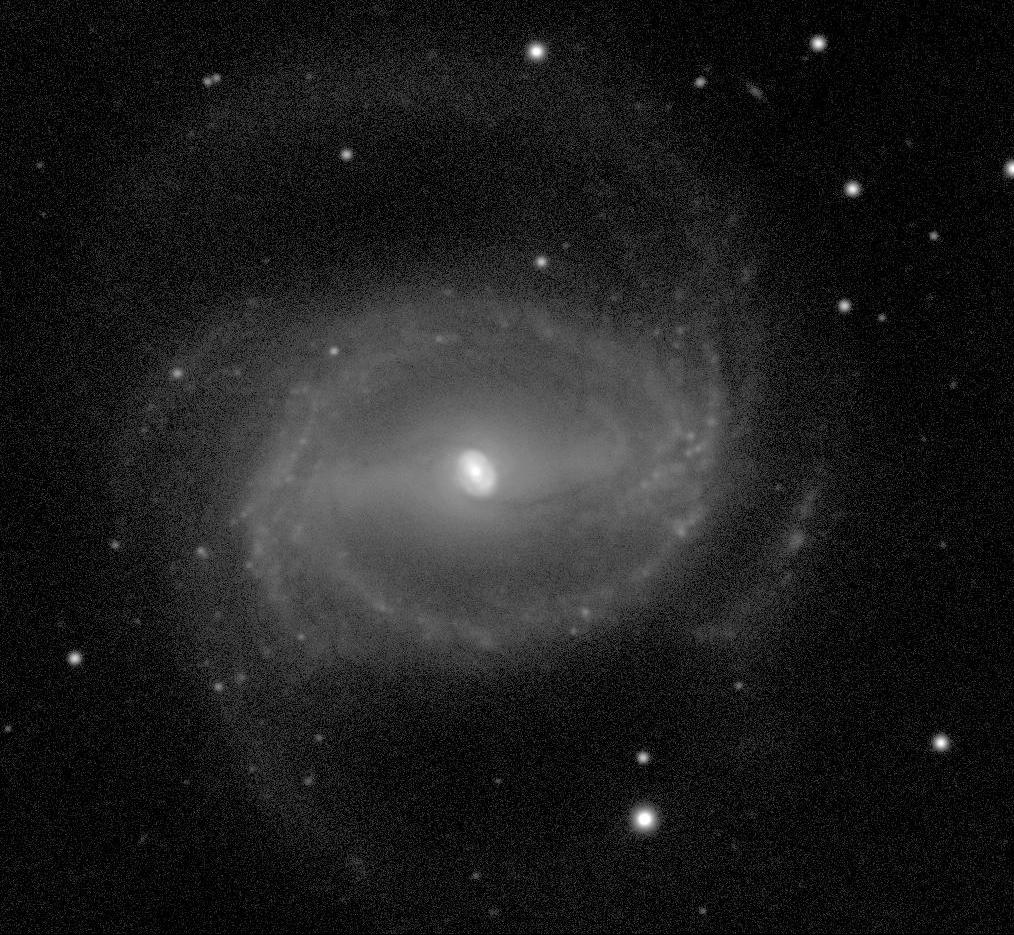

De Vaucouleurs Atlas Type: (R1')SB(r)ab
Filter: B
Telescope: CTIO 1.5-m
North up , East left
Field Dimensions: 7.4 x 6.8 arcminutes
RC3 Type: (R')SB(r)ab
RSA Type: SBb(s)I-II
Surface Brightness Range Displayed: 17.5-26.0 mag per square arcsec
Absolute Blue Magnitude: -19.7
De Vaucouleurs Atlas Description:
By any standard, NGC 1433 is a remarkable object. Showing virtually every morphological feature a galaxy can have and still be considered normal, NGC 1433 is dominated by star-forming ringlike features. The galaxy has been the subject of very detailed studies (Buta 1986b; Buta et al. 2001b), and is a prototype resonance ring galaxy. The morphology is defined by a strong bar encircled by a large inner ring that is made of tightly wrapped, knotty spiral arms. One way to view the ring is that it is made of four separate spiral sections that come together in its major and minor axis regions. Buta (1986b) argued that this four-part nature favors the interpretation of the ring as an inner 4:1 resonance feature (see Schwarz 1984a). Outside the inner ring , an R1' outer pseudoring is seen. This feature is faint and relatively smooth compared to the inner ring , and also is somewhat asymmetric. The Sab classification is a mean of the Sa type implied by the smooth outer arms and the Sb type implied by the knotty inner ring . Also, the tightness of the spiral structure defining the ring merits an Sab classification.
Of particular interest is the intrinsic shape and alignment of the inner ring , which is 12 kpc in diameter (Buta et al. 2001b). The apparent nearly face-on orientation of the outer disk of NGC 1433 led de Vaucouleurs to suggest that inner SB rings may in general be elongated parallel to bars. That this is indeed correct in the case of NGC 1433 is shown by Buta (1986b) and Buta et al. (2001b), who used two-dimensional optical (H-alpha) Fabry-Perot velocity data to show that the kinematic line of nodes is oriented nearly perpendicular to the major axis of the inner ring . That is, the galaxy is tilted nearly around the minor axis of the ring, not its major axis. When deprojected around the line of nodes for an inclination of 33o (Buta 1986b; Buta et al. 2001b), the intrinsic axis ratio of the inner ring is 0.63, which is exceptionally elongated compared to the average, 0.81+/-0.06, for SB inner rings (Buta 1995a).
The color index map highlights the intriguing structure inside the inner ring . There is a lack of star formation in the bar region except for a ridge of blue colors lying on the leading side of the western bar dust lane. Both bar dust lanes are well-defined and curve around the central area. Further out, the western lane is straight while the eastern lane branches and curves. In the central region, a small blue nuclear ring is found that appears elongated at 62o to the projected bar axis. The ring is defined by only a few discrete knots, and star formation is detected also inside the main ridge of blue colors. A small red nucleus is found inside this region. The color index map also highlights some asymmetry in this region.
Other interesting features of this galaxy are the two short spiral arcs lying just outside the leading sections of the inner ring . These features, called ``plumes " by Buta (1984) because of their feather-like appearance, are curved in the same manner as the inner ring and lie along an ellipse oriented parallel to the bar, just like the inner ring . Each plume has a bright superassociation; the one in the east plume is compact and not resolved in the images. These superassociations lie almost exactly opposite each other relative to the nucleus, suggesting that they are dynamically induced objects. What the plumes appear to represent are residual traces of a characteristic m=4 spiral pattern that may form in the presence of bars (Rautiainen, Salo, and Buta 2004). ESO 566-24 (Plate 82) is an example where the full pattern is present. Rautiainen, Salo, and Buta (2004) show that such a pattern probably develops between the inner and outer 4:1 resonances. In the presence of a strong bar, the two extra arms may not be able to cross into the areas of the bar Lagrangian points , where orbits would be unstable. Since the features are very rare (Buta 1984), it is likely that plumes are transient phenomena.
Buta et al. (2001b) show that the apparent morphology of NGC 1433 hardly changes from 0.44 to 1.6 microns. Although the bar dust lanes disappear and the light distribution is smoother, the inner ring is still a tightly-wrapped spiral in the near-IR, indicating that an older component underlies the bright star-forming ring. The outer arms still form a pseudoring but the plumes are very weak. The classification would change to (R')SB(r)a in the near-IR, a one-stage difference as is typical according to Eskridge et al. (2002).